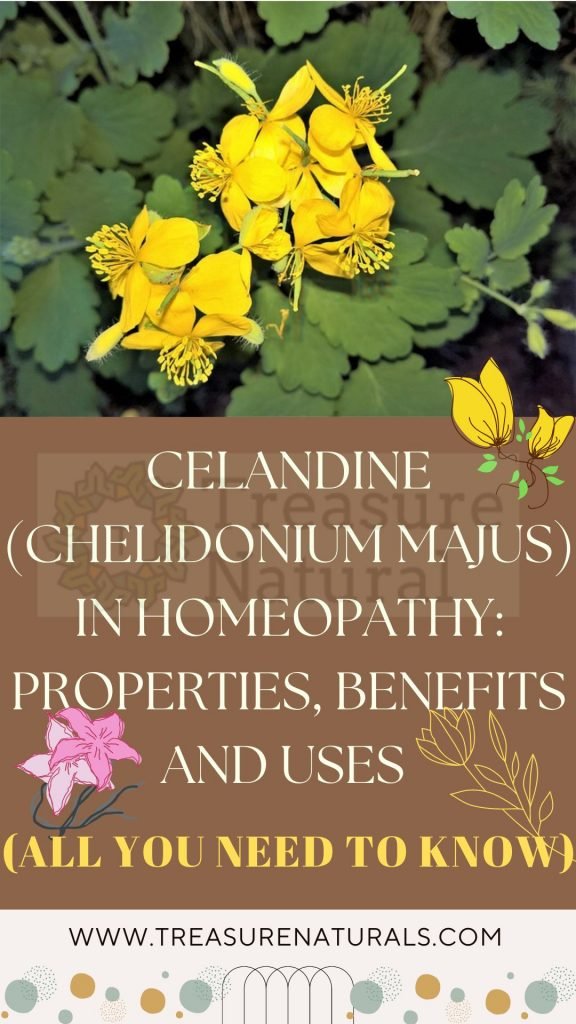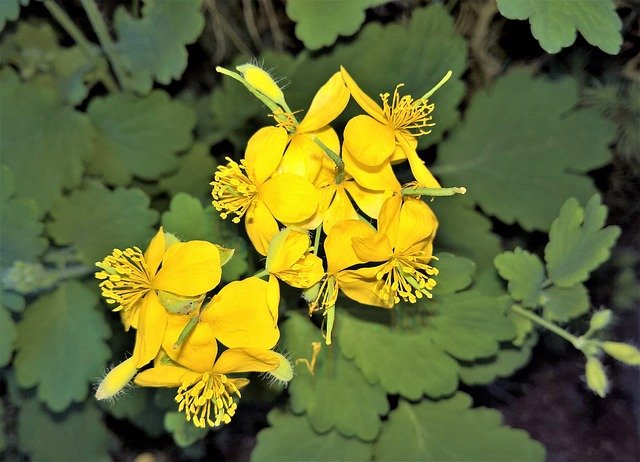
Celandine (Chelidonium majus), a plant from which the homeopathic remedy Chelidonium is obtained, belongs to the Papaveraceae family and is known for its antispasmodic, cholagogue and choleretic properties. The field of action of this remedy is mainly disorders of the liver and bile.
Chelidonium majus: plant
Celandine is a herbaceous plant of the Papaveraceae family native to Europe and the temperate and colder zones of Asia, which today grows all over the world.
It is a tendentially toxic plant whose active ingredients are essentially very powerful alkaloids: berberine, coptisine, chelidonin, sanguinarin, allocriptopin have a cholagogue, choleretic and lipid-lowering effect on the liver and biliary tract.
When torn, a yellow latex contained in all its parts, including in the roots, comes out of the plant. According to paracelsus’ “signature theory” (according to which the disease and the suitable remedy had common characteristics), the yellow and poisonous juice of this plant suggests that it is an ideal remedy for liver disorders such as jaundice. It is therefore no coincidence that already the doctors of antiquity, such as Galen and Dioscorides, used it to treat jaundice. The latex present in its stems, if properly treated, is rich in active ingredients that give the plant different medicinal properties:
- antispasmodic properties useful in case of cramps and against asthma;
- purgative, sedative and spasmolytic properties;
- antifungal properties;
- cholagogue and choleretic properties useful for the care of the liver;
- sedative properties, useful against insomnia and nervousness.
The flowering of the plant occurs from May to September, when the bluish green leaves begin to produce golden-yellow flowers with four petals arranged in small umbrellas. The ovoid seeds produced by the plant are rich in nutrients, which ants find very tasty.
And now here are some small curiosities: the name Chelidonium comes from the Greek chelidôn, which means swallow. Some argue that it was given this name because flowering begins when the swallows arrive and ends when they leave for the south. Others say that it is due to the story that the swallows used the branches of celandine to help their young open their eyes. The plant is also commonly known by the name “leek grass” because it was, and still is, used to remove leeks and warts.
In the past, moreover, the alchemists tried to transform this yellow plant into gold and used it in the search for the philosopher’s stone so much so that they gave it the name of coeli donum, a gift from heaven.
Chelidonium : homeopathic remedy and properties
The homeopathic remedy Chelidonium is obtained from the fresh flowering plant and is mainly used for the treatment of diseases of the gallbladder and liver as well as for some eye diseases. According to the theory of similarity, in fact, the remedy Chelidonium performs an elective action at the level of the liver with hypertrophy of the right lobe, biliary stasis and production of indole. The remedy Chelidonium was tested by Hahnemann and included in the Pure Materia Medica.
It is a homeopathic remedy that is traditionally used in the following cases:
- disorders of the liver and biliary tract;
- jaundice;
- hepatitis;
- indigestion;
- nausea and vomiting;
- dilation of the upper abdomen;
- headache associated with liver disorders;
- leeks and warts.
Typically the symptoms manifest themselves in the right side of the body and a characteristic symptom is represented by a strong pain under the right shoulder blade, with stomach disorders.
The homeopathic remedy chelidonium for Jaundice
Jaundice is a condition in which the skin and sclera (the white part of the eye) take on a yellowish color. It often affects children in the first week of life, but can appear at any age for different problems: blood diseases, liver disorders, infections, taking certain medicines etc …
What generates jaundice is the accumulation of bilirubin, a yellow molecule present in the hemoglobin of red blood cells. At the end of their life cycle the latter should be disposed of by the liver; when this does not happen, the accumulation of bilirubin can occur, which gives the skin the yellowish color typical of jaundice.
Even in case of jaundice there are very useful homeopathic remedies, such as Chelidonium that is used when the skin is very yellow (acute jaundice), there is severe itching, pain in the right scapula that worsens with movement and the liver is enlarged and painful.
Chelidonium: constitutional type

Chelidonium constitutional subjects are generally slender, beautiful and have a dominant and dictatorial behavior, indifferent to the authority and opinions of others. They are people who are convinced that they are always right and very realistic, in fact they avoid relying on personal feelings rather than on concrete facts. These are subjects dedicated to work, which is mostly manual. They prefer heavy foods that however compromise their digestive system. As a result they often suffer from disorders of the liver and bile that cause the appearance of yellow spots on the skin.
Below are the main characteristics of the subject:
- stinging pain of the right hypochondrium radiating to the back;
- fixed, constant, stinging or dull pain, at the lower corner of the right scapula;
- soft tongue and floppy;
- nausea with bitter taste;
- mental laziness;
- drowsiness and fatigue.
In addition to a particular propensity to contract diseases of the intestinal tract, the Chelidonium type also demonstrates a certain predisposition to inflammation of the respiratory tract, migraines or joint discomfort.
Usually the symptoms presented are aggravated with the heat, with climate change, around 4 am and in the afternoon, while they improve after eating, with the intake of milk and other hot drinks and with a strong pressure.






